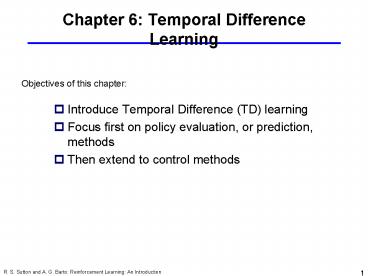Chapter 6: Temporal Difference Learning - PowerPoint PPT Presentation
1 / 33
Title:
Chapter 6: Temporal Difference Learning
Description:
Focus first on policy evaluation, or prediction, methods. Then extend ... Statistics of arrivals and departures are unknown. n=10, h=.5, p=.06. Apply R-learning ... – PowerPoint PPT presentation
Number of Views:104
Avg rating:3.0/5.0
Title: Chapter 6: Temporal Difference Learning
1
Chapter 6 Temporal Difference Learning
Objectives of this chapter
- Introduce Temporal Difference (TD) learning
- Focus first on policy evaluation, or prediction,
methods - Then extend to control methods
2
TD Prediction
Policy Evaluation (the prediction problem)
for a given policy p, compute the state-value
function
Recall
target the actual return after time t
target an estimate of the return
3
Simple Monte Carlo
4
Simplest TD Method
5
cf. Dynamic Programming
T
T
T
6
TD methods bootstrap and sample
- Bootstrapping update involves an estimate
- MC does not bootstrap
- DP bootstraps
- TD bootstraps
- Sampling update does not involve an expected
value - MC samples
- DP does not sample
- TD samples
7
Example Driving Home
(5)
(15)
(10)
(10)
(3)
8
Driving Home
Changes recommended by Monte Carlo methods (a1)
Changes recommended by TD methods (a1)
9
Advantages of TD Learning
- TD methods do not require a model of the
environment, only experience - TD, but not MC, methods can be fully incremental
- You can learn before knowing the final outcome
- Less memory
- Less peak computation
- You can learn without the final outcome
- From incomplete sequences
- Both MC and TD converge (under certain
assumptions to be detailed later), but which is
faster?
10
Random Walk Example
Values learned by TD(0) after various numbers of
episodes
11
TD and MC on the Random Walk
Data averaged over 100 sequences of episodes
12
Optimality of TD(0)
Batch Updating train completely on a finite
amount of data, e.g., train repeatedly on
10 episodes until convergence. Compute
updates according to TD(0), but only update
estimates after each complete pass through the
data.
For any finite Markov prediction task, under
batch updating, TD(0) converges for sufficiently
small a. Constant-a MC also converges under
these conditions, but to a difference answer!
13
Random Walk under Batch Updating
After each new episode, all previous episodes
were treated as a batch, and algorithm was
trained until convergence. All repeated 100 times.
14
You are the Predictor
Suppose you observe the following 8 episodes
A, 0, B, 0 B, 1 B, 1 B, 1 B, 1 B, 1 B, 1 B, 0
15
You are the Predictor
16
You are the Predictor
- The prediction that best matches the training
data is V(A)0 - This minimizes the mean-square-error on the
training set - This is what a batch Monte Carlo method gets
- If we consider the sequentiality of the problem,
then we would set V(A).75 - This is correct for the maximum likelihood
estimate of a Markov model generating the data - i.e, if we do a best fit Markov model, and assume
it is exactly correct, and then compute what it
predicts (how?) - This is called the certainty-equivalence estimate
- This is what TD(0) gets
17
Learning An Action-Value Function
18
Sarsa On-Policy TD Control
Turn this into a control method by always
updating the policy to be greedy with respect to
the current estimate
19
Windy Gridworld
undiscounted, episodic, reward 1 until goal
20
Results of Sarsa on the Windy Gridworld
21
Q-Learning Off-Policy TD Control
22
Cliffwalking
e-greedy, e 0.1
23
The Book
- Part I The Problem
- Introduction
- Evaluative Feedback
- The Reinforcement Learning Problem
- Part II Elementary Solution Methods
- Dynamic Programming
- Monte Carlo Methods
- Temporal Difference Learning
- Part III A Unified View
- Eligibility Traces
- Generalization and Function Approximation
- Planning and Learning
- Dimensions of Reinforcement Learning
- Case Studies
24
Unified View
25
Actor-Critic Methods
- Explicit representation of policy as well as
value function - Minimal computation to select actions
- Can learn an explicit stochastic policy
- Can put constraints on policies
- Appealing as psychological and neural models
26
Actor-Critic Details
27
Dopamine Neurons and TD Error
W. Schultz et al. Universite de Fribourg
28
Average Reward Per Time Step
the same for each state if ergodic
29
R-Learning
30
Access-Control Queuing Task
Apply R-learning
- n servers
- Customers have four different priorities, which
pay reward of 1, 2, 4, or 8, if served - At each time step, customer at head of queue is
accepted (assigned to a server) or removed from
the queue - Proportion of randomly distributed high priority
customers in queue is h - Busy server becomes free with probability p on
each time step - Statistics of arrivals and departures are unknown
n10, h.5, p.06
31
Afterstates
- Usually, a state-value function evaluates states
in which the agent can take an action. - But sometimes it is useful to evaluate states
after agent has acted, as in tic-tac-toe. - Why is this useful?
- What is this in general?
32
Summary
- TD prediction
- Introduced one-step tabular model-free TD methods
- Extend prediction to control by employing some
form of GPI - On-policy control Sarsa
- Off-policy control Q-learning and R-learning
- These methods bootstrap and sample, combining
aspects of DP and MC methods
33
Questions
- What can I tell you about RL?
- What is common to all three classes of methods?
DP, MC, TD - What are the principle strengths and weaknesses
of each? - In what sense is our RL view complete?
- In what senses is it incomplete?
- What are the principal things missing?
- The broad applicability of these ideas
- What does the term bootstrapping refer to?
- What is the relationship between DP and learning?































